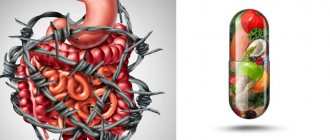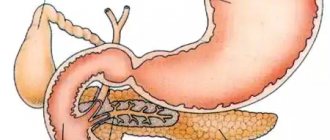Home>Articles>The main causes of vomiting blood after drinking alcohol and methods of treatment
quick menu (hide)
- Features and accompanying manifestations
- Main reasons: why vomits blood after drinking alcohol
- How to help
- How to treat a person if he vomits blood after drinking alcohol
- Rehabilitation period
- What are the consequences of lack of treatment?
Alcohol negatively affects all organs and systems. This has been proven by many tests. The situation is more dangerous if there are diseases of the digestive system. Patients may experience vomiting of blood after drinking alcohol. This is a manifestation of dangerous processes in the body, so urgent treatment will be required.
Content:
- The main causes of nausea and vomiting after heavy drinking
- When is hospitalization required?
- Severe vomiting after heavy drinking - what to do
- Medicines to help with vomiting
- Infusion therapy
- Other ways to combat the gag reflex during alcohol poisoning
Vomiting after a long binge is a symptom indicating that the body is trying to cleanse itself of accumulated toxins. If it repeats very often, occurs every time in response to eating or drinking liquid, you need to sound the alarm - in such a situation you cannot do without an IV.
The situation is even worse for an alcohol addict if there are blood impurities in the vomit. They talk about the development of severe gastrointestinal disease and internal bleeding. Therefore, if vomiting blood occurs after a binge , you should get qualified drug treatment assistance as quickly as possible. Under no circumstances should you self-medicate with such dangerous symptoms.
How to help
If a person finds himself in such a situation, he needs the help of others. In such a situation, you must perform the following actions:
- Put the patient to bed. It should be positioned on its side. This way, vomit will not accumulate in the respiratory tract and an attack of suffocation can be avoided.
- Cover with a blanket and open the windows to allow oxygen into the room.
- Warm the patient. This will lead to improved blood circulation.
- To prevent blood stagnation, the person should be turned over periodically. The patient should not be left unattended. If his condition worsens, he may choke on vomit.
- Place a basin near the bed, as vomiting may continue for some time.
- Ensure normal drinking regime. A person should drink more clean water. Sorbents will also help. It is enough to give the patient activated carbon to drink to speed up the cleansing of the body.
- Measure pulse and blood pressure, if available.
You should not feed the victim, because eating will only complicate the functioning of the digestive system and worsen the condition. That's all you need to do in this condition.
Thanks to proper first aid, you can alleviate the condition of the victim and prevent the development of complications. It is important to get the patient to the hospital as quickly as possible. Especially if high fever joins the general symptoms.
The main causes of nausea and vomiting after heavy drinking
As a result of toxic compounds entering the body, as well as due to their release during certain biochemical reactions, the patient exhibits symptoms of poisoning. This is not only vomiting and severe nausea, but also increased body temperature, muscle pain, discomfort in the abdomen and right hypochondrium, and severe weakness.
For negative symptoms to go away, you need to cleanse your body of toxins. In the case of alcoholism, the latter are the breakdown products of ethanol. If the drinker’s condition does not stabilize during the day, you need to be wary. Very often, signs of intoxication indicate:
- ulceration and damage to the mucous membranes of the stomach;
- liver failure and increased bilirubin levels;
- acute renal failure, provoked by a sharp increase in the concentration of acetone in the blood;
- increase in intracranial pressure.
Also, sometimes vomiting after binge drinking indicates other pathologies that occur in a sluggish chronic form. After provocation by alcohol, many diseases worsen, sometimes to such an extent that life is threatened.
Types of food poisoning
- Microbial. This type includes poisoning from spoiled or contaminated products.
- Intoxication with chemicals. It occurs when toxins enter the gastrointestinal tract and requires urgent medical attention.
- Poisoning with poisonous mushrooms, fish or meat, plants. An urgent visit to a doctor is recommended. Source: B.Zh. Suleizhan, W.K. Keldikulova Foodborne toxic infections // Journal of the Almaty State Institute for Advanced Training of Doctors, 2011, No. 1
When is hospitalization required?
Before we tell you how to stop vomiting after a binge, we list the situations in which hospitalization is indicated. Among them:
- the symptom persists for longer than a day;
- impurities of scarlet blood are visualized in the vomit, which is typical for a rupture of the mucous membrane, a tumor neoplasm in the stomach, or a perforated ulcer;
- discharged masses have a green tint, indicating acute pancreatitis or failure of bile outflow;
- severe acute pain in the right hypochondrium;
- gagging occurs suddenly and does not subside even after the stomach is completely cleansed;
- Strong headache;
- vomit acquires a black color, which is observed with a bleeding ulcer when blood is mixed with gastric juice.
It is important to understand that while intoxicated, a person does not notice many dangerous symptoms. As long as the feeling of euphoria persists, he may not feel pain. Therefore, it is important to constantly monitor the addict if he vomits frequently. If you suspect something is wrong, call a drug treatment ambulance immediately.
If a person is very drunk, he should not be allowed to lie on his back. He should sleep on his stomach or sit on a chair. Otherwise, the risk of choking on vomit will increase.
How to treat a person if he vomits blood after drinking alcohol
After the victim is admitted to a medical facility, you first need to find out why he is vomiting blood after drinking alcohol. For this purpose, diagnostic studies of internal organs are carried out. is mandatory , during which a probe with a camera at the end is placed in the oral cavity and advanced through the esophagus into the stomach, checking the condition of the mucous membranes as it moves. Blood and urine are also checked. After receiving the results, a diagnosis will be made and treatment will be prescribed.
If you seek help in time, you can get by with medications. In severe cases, surgery or endoscopic techniques may be required. Since this condition can occur for various reasons, complex therapy is required.
First, to remove blood clots, the stomach is washed with cold water. Its temperature should not be higher than +4 degrees. Using a probe, the intensity of the bleeding is monitored. After this, medications . To narrow the blood vessels, they resort to blockade with adrenaline. Treatment includes medications such as vasodilators and vasoconstrictors, as well as balloon tamponade with two types of probes.
Severe vomiting after heavy drinking - what to do
It’s good if the drinker’s relatives know how to stop vomiting after an alcoholic binge. But they cannot always cope with intoxication on their own. If the above listed dangerous symptoms occur, attempting treatment at home is strictly prohibited. Only an experienced narcologist who has a whole arsenal of modern antiemetic drugs will help here.
If the patient feels tolerant and does not vomit very often, he can be helped as follows:
- Give a weak solution of potassium permanganate to drink. It should have a light pink color (in no case saturated, as it can burn the mucous membranes).
- Cleanse the intestines with an enema.
- Give an absorbent tablet (for example, activated carbon).
It is also important to give the patient plenty of fluids to drink. In case of intoxication, still mineral water or herbal decoctions are suitable.
First aid
First aid is provided to help the patient wait for doctors and allow them to provide qualified medical support. Do not try to give the person medication; you should not rinse the stomach yourself, as these actions can cause complications.
Providing assistance at home
First of all, provide the person with peace. In case of loss of consciousness, lay the victim on his side. This way, the stomach contents and tongue will not block the airways. Cover the patient. Provide fresh air into the room to help the victim remain conscious.
The second stage of assistance is to restore lost fluid. Still water, chamomile tea, and calendula decoction are perfect. It is necessary to give the patient 1-2 sips of water. A large amount of liquid will provoke another attack of vomiting. Do not give the person food until the doctor arrives.
Poisoning can be relieved with activated carbon and polysorb. These medications will not cause harm, but will absorb the toxins that caused the vomiting. Before taking activated carbon, be sure to crush it and dilute the polysorb in water. If there is excessive bleeding, give the patient Cerucal. This will calm stomach cramps and spare the alcoholic from additional internal damage.
Medical assistance
After arrival, the emergency doctor will carry out all the necessary manipulations that will help remove the threat to a person’s life. Next, in order to prescribe effective treatment, the doctor needs to make a diagnosis and also determine the etiology of the disease.
The patient will need to undergo tests:
- CBC (complete blood count);
- OAM (general urinalysis);
- coprogram;
- ECG;
- gastroscopy;
- undergo radiography, ultrasound.
In case of prolonged use of alcoholic beverages, the patient will need to undergo detoxification therapy.
Medicines to help with vomiting
For frequent vomiting, when there is a risk of dehydration, doctors use effective antiemetic drugs (antiemetics). They allow you to stop painful attacks and prevent health-hazardous consequences. They work by blocking various pathogenetic components of the gag reflex.
Antiemetics include serotonergic and dopaminergic drugs, some antihistamines, anticholinergic drugs, and NK1 receptor antagonists. It is not recommended to take them without a doctor's prescription, as negative side effects may occur.
Diagnosis of the condition
For medical care to be effective, it is important to accurately determine the cause of complications. At the first stage, examined . It is important to assess how long he has been drinking alcohol, when the vomiting began, whether it happened once or several times, and what the intensity of the bleeding is based on the color of the vomit. Next, associated symptoms and the presence of chronic diseases are determined. This will allow a preliminary diagnosis to be made. After this, tests are scheduled at a medical institution. The following will be required:
- Gastroscopy.
- Ultrasonography.
- Radiography.
- Complete blood and urine examination.
Depending on the results obtained, tactics . This can be conservative treatment or surgical intervention.
Infusion therapy
A drip is a simple and affordable way to treat alcohol intoxication. With its help you can:
- eliminate signs of dehydration;
- normalize water-salt balance;
- improve the functioning of internal organs.
If the poisoning is severe, a drip is given two to three times a day. For mild forms of intoxication, it is enough to carry out the procedure once a day.
Types of nausea
After drinking alcohol, you may vomit blood.
Bleeding does not accompany vomiting. However, it is preceded by nausea, and a person may vomit blood. When the pathology is severe, the esophagus is often damaged. This is why bleeding occurs. Among other things, it can bleed due to gastric ulcers and erosions. The condition is on the verge of life, so the patient is urgently called to the emergency room.
Often a drunk person vomits bile. In this case, we are talking about gastric emptying, which occurs after an unpleasant sensation in the epigastric region. When drinking alcohol, the gastrointestinal tract malfunctions, and intestinal motility suffers. Reverse reflux is not uncommon: then the contents of the duodenum enter the stomach. That is why bile admixture appears in the vomit. This condition also requires urgent assistance from medical professionals.
Vomiting alcohol bile is a bad option. The sufferer turns inside out, and the stomach contents that come out contain greenish-yellow mucus. When the internal organ is cleansed in this way, a bitter taste is felt in the mouth. Vomiting attacks also occur when the stomach is already empty. Which is a sign of a malfunction of the digestive system, since normally there should not be bile there.
Biliary vomiting attacks are one of the main troubles associated with the biliary tract, gallbladder, and liver. If problems continue and violations are not detected in time, the outcome may be disastrous.
Reflexive evacuation from the stomach, which occurs after nausea, is unsafe. A drunk can choke on the erupted masses.
If a drunk gets sick, it is better to call an ambulance or a drug treatment clinic. The team will come to the house. They will do a gastric lavage. Calling a narcologist at our medical institution “Alcocenter” (Moscow) guarantees the patient comprehensive treatment and elimination of the negative consequences of binge drinking. The patient will be helped to get rid of nausea. If necessary, a dropper is placed. The drinker faces rehabilitation.
A preliminary consultation is possible. Center contacts are on the website. Services are provided under license. Health workers inform that there will be no leakage of the client’s personal data, the treatment is anonymous.
A personal therapeutic program is selected.
If the patient feels more or less normal, chamomile or mint infusion is taken at home. Infusions will calm the gall bladder.
When a drunk gets sick at the mention of alcohol-containing products, this is a good sign: there is no dependence or addiction. Those suffering from alcoholism get a “hangover” in the morning.
Other ways to combat the gag reflex during alcohol poisoning
The following simple techniques help some people with alcohol intoxication:
- taking five grams of vitamin C;
- drinking small sips of a weak solution of baking soda (take 5 teaspoons of the composition per liter of water);
- using freshly squeezed lemon and orange juice (but you should not drink them if you have stomach diseases);
- Take three tablespoons of glucose solution every hour.
It is clear that these recommendations will not help with severe vomiting after binge drinking. You can resort to them only in case of nausea or periodic vomiting. If an alcohol addict feels very bad and there is blood in the vomit, it is unacceptable to refuse medical help.
Disease prevention
- The child’s personal hygiene: washing hands before and after walking, after using the toilet, before eating.
- Lack of raw water, ready-made factory meals and unboiled milk in the diet.
- Compliance with food storage conditions.
- Careful selection of food products, taking into account expiration date and quality.
Treatment of small cracks, scratches and abrasions on the hands to prevent germs from entering the body.
Sources:
- H.D. Abdikhakimovich. Features of the course of food toxic infections // Pediatrician, 2022, v. 8, special issue
- B.Zh. Suleizhan, W.K. Keldikulova. Foodborne toxic infections // Journal of the Almaty State Institute for Advanced Medical Studies, 2011, No. 1
- A.V. Gorelov. Therapy of acute intestinal infections in children in modern conditions // Issues of modern pediatrics, 2004, vol. 3, no. 4, pp. 72-78
Vostrikova Ekaterina Borisovna Clinic
Author of the article
Vostrikova Ekaterina Borisovna
Specialty: gastroenterologist
Experience: 14 years
The information in this article is provided for reference purposes and does not replace advice from a qualified professional. Don't self-medicate! At the first signs of illness, you should consult a doctor.
Vomiting coffee grounds in oncology
Vomiting coffee grounds or mixed with unchanged blood is a common complication of stomach and esophageal cancer. The likelihood that the symptom is caused by cancer is especially high if the patient is over 55 years old. Often the patient loses a lot of weight.
In 2000, the journal JPSM (Journal of Pain and Symptom Management) published the results of a study in which researchers observed 800 patients with advanced cancer and assessed how often they experienced gastrointestinal bleeding. During the lifelong follow-up period, 18 patients developed overt symptoms of gastrointestinal bleeding: 12 had vomiting coffee grounds, 3 had melena (black, tarry stool), and 3 had both symptoms. The overall complication rate was 2.25%, while in the general population it was 0.1% (1 hospitalization for gastrointestinal bleeding per 1000 population).
According to some data, stomach cancer is complicated by bleeding in 4.6–23.4% of cases. Most often this occurs with stage III–IV tumors, usually located in the body or in the antral (lower, near the junction with the duodenum) part of the stomach. Main reasons:
- tumor disintegration;
- tumor ulceration;
- rupture of a blood vessel affected by a tumor;
- tumor destruction, purulent process, destruction and thrombosis of blood vessels, followed by necrosis and disintegration of tumor tissue.
The risk of gastrointestinal bleeding is quite high in patients with primary and metastatic liver cancer. In this case, portal hypertension occurs, varicose veins of the esophagus, and blood clotting decreases. Sometimes vomiting coffee grounds occurs as a complication of pancreatic cancer.
The risk of gastrointestinal bleeding in a cancer patient increases if pain is controlled with the use of nonsteroidal anti-inflammatory drugs.
Diagnosis of Mallory-Weiss syndrome
Bleeding in the stomach, which comes from a longitudinal crack formed in the mucous membrane of the walls, is Mallory-Weiss syndrome. An accurate diagnosis of the disease can be made using endoscopic examination. Detection of an area damaged by a crack is accompanied by medical measures aimed at protecting the health and life of the patient .
If there is significant blood loss, the person is given maintenance saline solutions. After therapy, the patient must give up alcohol entirely. A freshly formed wound should not experience additional toxic effects. If necessary, alcohol dependence is treated, the following procedures are carried out:
- detoxification of the body;
- relieving withdrawal symptoms;
- strengthening therapy.
Heavy, fatty, spicy foods are excluded from the patient's diet . The main dishes are boiled or steamed foods. In severe cases, when therapeutic methods are not effective, surgical intervention is resorted to.
What other symptoms may occur with bleeding in the gastrointestinal tract?
Vomiting coffee grounds may be accompanied by symptoms such as melena (black, tarry stool), abdominal pain, pallor, weakness, and dizziness. With serious blood loss, such menacing manifestations appear as chest pain, severe dizziness, loss of consciousness, cold sticky sweat, shallow rapid breathing, and a decrease in the amount of urine. If help is not provided in time, a state of shock develops and the patient may die.
If the bleeding is minor, there may be no symptoms. It is especially difficult to recognize this complication if the patient has anemia or cancer cachexia (exhaustion). As a rule, in such cases, a stool test for occult blood helps to establish the diagnosis.










